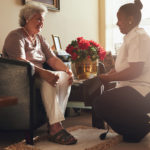
Residents of nursing homes and long-term care facilities are prone to poorer oral health as they may be less able to maintain daily oral hygiene and have reduced access to professional dental care. Community-acquired pneumonia (CAP) is higher in nursing home residents than in community-dwelling older people with those with dementia have a higher risk. Studies have suggested that improved oral hygiene and regular oral health care may reduce the incidence of pneumonia and the National Institute for Health and Care Excellence (NICE) have recommended that care homes have plans to promote resident’s oral health (Dental Elf – 11h Jul 2016).
The aim of this Cochrane review update was to assess the effects of oral care measures for preventing nursing home-acquired pneumonia in residents of nursing homes and other long- term care facilities.
Methods
Searches were conducted in the Cochrane Oral Health’s Trials Register, Cochrane Central Register of Controlled Trials (CENTRAL), Medline, Embase, CINAHL, ClinicalTrials.gov and the WHO International Clinical Trials Registry Platform. Randomised controlled trials (RCTs) evaluating the effects of oral care measures (brushing, swabbing, denture cleaning mouthrinse, or combination) in residents of any age in nursing homes and other long-term care facilities were considered. Two reviewers independently selected studies extracted data and assessed risk of bias using the revised Cochrane Risk of Bias tool (RoB 2.0). Dichotomous outcomes were reported as risk ratios (RRs), continuous outcomes as mean differences (MDs) and time to event data as hazard ratios (HRs) or incidence rate ratios (IRR).
Results
- 6 RCTs involving 6244 patients were included.
- 3 studies were conducted in Japan, 2 in the USA and one in France.
- All 6 RCTs were considered to be at high risk of bias.
- 5 studies (5018 patients) with consistent results provided insufficient evidence of a difference between professional oral care and usual (simple, self-administered) oral care in the incidence of pneumonia (data not pooled because of variation in study design and follow-up duration).
- 2 studies (454 patients) provided low-certainty evidence that professional oral care may reduce the risk of pneumonia-associated mortality compared with usual oral care at 24 months’ follow-up, RR = 0.43 (95%CI; 0.25 to 0.76). Another study (2513 patients) reported insufficient evidence of a difference for this outcome at 18 months’ follow-up.
- 3 studies measured all-cause mortality and identified insufficient evidence of a difference between professional and usual oral care at 12 to 30 months’ follow-up.
- Only one study (834 patients) measured the adverse effects of the interventions. The study identified no serious events and 64 non- serious events, the most common of which were oral cavity disturbances (not defined) and dental staining.
- No studies evaluated oral care versus no oral care.
Conclusions
The authors concluded: –
Although low-certainty evidence suggests that professional oral care may reduce mortality compared to usual care when measured at 24 months, the effect of professional oral care on preventing NHAP remains largely unclear. Low-certainty evidence was inconclusive about the effects of this intervention on incidence and number of first episodes of NHAP. Due to differences in study design, effect measures, follow-up duration, and composition of the interventions, we cannot determine the optimal oral care protocol from current evidence. Future trials will require larger samples, robust methods that ensure low risk of bias, and more practicable interventions for nursing home residents.
Comments
This Cochrane review update to the 2018 version (Dental Elf – 10th Oct 2018) includes two additional trials. All of the included studies we considered to be at high risk of bias this because blinding of the patients and caregivers was not possible in any of the studies. There was low certainty evidence that professional oral care may reduce mortality however impact on other outcomes was uncertain. The number of events (cases of CAP etc) was low even studies with larger sample sizes so future studies will need to recruit larger sample sizes in order to provide better estimates and more definitive conclusions. In addition to larger sample sizes the reviewers recommend a range of oral health care measures should be examined and that incidence measures take into account variable follow-up periods and potential confounders. Notwithstanding any impact on general health and wellbeing and the need for additional research in this area good oral care should be a key component of nursing home care
Links
Primary Paper
Cao Y, Liu C, Lin J, Ng L, Needleman I, Walsh T, Li C. Oral care measures for preventing nursing home-acquired pneumonia. Cochrane Database Syst Rev. 2022 Nov 16;11:CD012416. doi: 10.1002/14651858.CD012416.pub3. PMID: 36383760.
Other references
Dental Elf – 11h Jul 2016
Oral Health should have same priority as general health in care homes says NICE
Dental Elf – 10th Oct 2018
